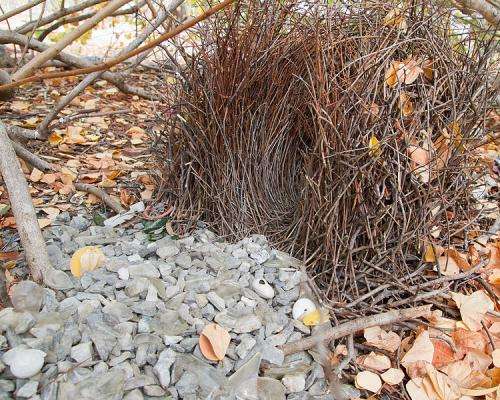April 2, 2014 report
Study shows male bowerbirds manipulate female color perception

(Phys.org) —A trio of researchers in Australia has found that there is more to bowerbird bowers and colored objects used by the males than has been previously thought. In their paper published in Proceedings of the Royal Society B: Biological Sciences, the team describes how in their study of bowerbird behavior and bower structure they discovered that activities by the males can lead to manipulation of the perception of color by the female.
Birds are notorious for their mating rituals, with males typically endowed with colorful plumage prancing for the attention of females. In this new effort, the researchers took a closer look at the mating rituals of bowerbirds who are famous for their elaborately constructed bowers.
Bowers are stage-like creations made from sticks and other material, by the male—they serve to provide a place for the male to dance and display an assortment of objects he's collected for observation by the female. The bower has three main components, two courts and an avenue. The courts are areas where the male performs while the female watches from the avenue in the center. The entire exercise, the researchers note, appears to be designed to capture and then hold the attention of the female.
In watching wild bowerbirds in action, the researchers noted that the male uses his bower to hide objects not being displayed and then to dazzle suddenly with colored objects meant to hold the attention of the female. What's not evident is that the rapid movement of colored objects appears to change the perception of color by the female.
In filming and chromatically studying the mating ritual of the birds, the team discovered that the court structure is neutral colored, making other objects in front of them stand out. The avenue, on the other hand, is made from reddish materials that cause what they describe as "chromatic adaptation"—where a viewer experiences a heightened sense of certain colors, such as lilac, green or red, which just happens to match the crown on the males head. They also noted the use of hiding and then flashing objects using the bower structure in specific ways—a means to grab the females attention.
Oddly, the color show doesn't appear to enhance the males' chance of mating, though it might increase his chances of landing the particular female that he wants, which may in the end mean that the fittest, brightest males, wind up with the strongest female reproducers.
More information: Visual effects in great bowerbird sexual displays and their implications for signal design, Proceedings of the Royal Society B, Published 2 April 2014 DOI: 10.1098/rspb.2014.0235
Abstract
It is often assumed that the primary purpose of a male's sexual display is to provide information about quality, or to strongly stimulate prospective mates, but other functions of courtship displays have been relatively neglected. Male great bowerbirds (Ptilonorhynchus nuchalis) construct bowers that exploit the female's predictable field of view (FOV) during courtship displays by creating forced perspective illusions, and the quality of illusion is a good predictor of mating success. Here, we present and discuss two additional components of male courtship displays that use the female's predetermined viewpoint: (i) the rapid and diverse flashing of coloured objects within her FOV and (ii) chromatic adaptation of the female's eyes that alters her perception of the colour of the displayed objects. Neither is directly related to mating success, but both are likely to increase signal efficacy, and may also be associated with attracting and holding the female's attention. Signal efficacy is constrained by trade-offs between the signal components; there are both positive and negative interactions within multicomponent signals. Important signal components may have a threshold effect on fitness rather than the often assumed linear relationship.
Journal information: Proceedings of the Royal Society B
© 2014 Phys.org




















